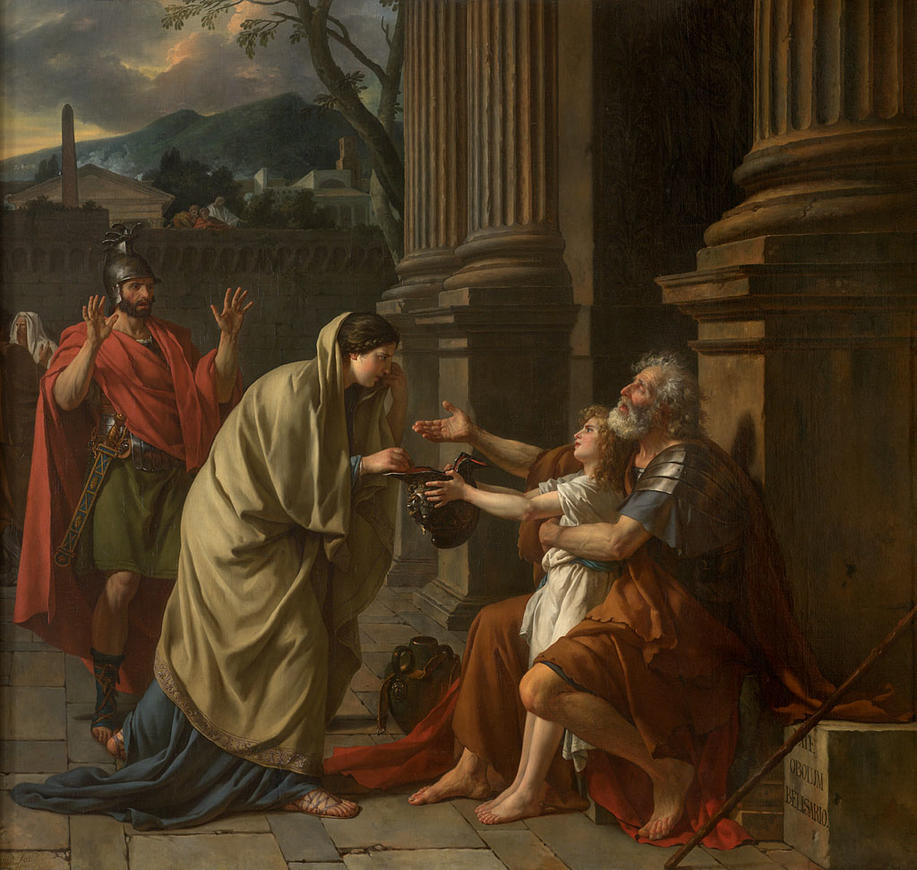The painting marks a turning point in the career of the painter and in the history of art. In a complete break with the light, shimmering, sensual art of the eighteenth century, it is truly an aesthetic manifesto. Four years before "Le Serment des Horaces, The Oath of the Horatii", probably David's most famous work, was exhibited in the Louvre, David has created the first neo-classical canvas.
But what is it, or, more to the point, who is it? The answer is in the corner of the picture, with the Latin inscription engraved on the stone: "Date obolum Belisario", which means "Give alms to Belisarius". Belisarius was a Byzantine general of the sixth century, unjustly accused of conspiracy against Emperor Augustus. This is the old man in the foreground. He is reduced to begging after having his eyes gouged out. In the background is one of the soldiers who fought under his orders showing surprise as he recognises him.
The episode is transposed into antiquity, and adapted to the taste of the day by the neo-classical approach. Here, references to antiquity are found everywhere: from the characters, with their exaggerated and codified gestures, their clothing and facial expressions, to the ancient statuary, and the landscape in the distance. The frieze composition is also inspired by ancient bas-reliefs.
Under the historical and moral imperative that all glory and every heroic gesture is futile, there is a sharp criticism of the monarchy. This strong commitment from David was welcomed by philosophers of the Enlightenment period, such as Diderot.
Inventory number: P. 436
Detail 1: The scene is perfectly framed by a set of horizontal and vertical lines, such as the columns and the stone floor.
Detail 2: In the center of the picture plane, the three hands punctuate the action. One hand implores, another gives and the last receives.

The painting marks a turning point in the career of the painter and in the history of art. In a complete break with the light, shimmering, sensual art of the eighteenth century, it is truly an aesthetic manifesto. Four years before "Le Serment des Horaces, The Oath of the Horatii", probably David's most famous work, was exhibited in the Louvre, David has created the first neo-classical canvas.
But what is it, or, more to the point, who is it? The answer is in the corner of the picture, with the Latin inscription engraved on the stone: "Date obolum Belisario", which means "Give alms to Belisarius". Belisarius was a Byzantine general of the sixth century, unjustly accused of conspiracy against Emperor Augustus. This is the old man in the foreground. He is reduced to begging after having his eyes gouged out. In the background is one of the soldiers who fought under his orders showing surprise as he recognises him.
The episode is transposed into antiquity, and adapted to the taste of the day by the neo-classical approach. Here, references to antiquity are found everywhere: from the characters, with their exaggerated and codified gestures, their clothing and facial expressions, to the ancient statuary, and the landscape in the distance. The frieze composition is also inspired by ancient bas-reliefs.
Under the historical and moral imperative that all glory and every heroic gesture is futile, there is a sharp criticism of the monarchy. This strong commitment from David was welcomed by philosophers of the Enlightenment period, such as Diderot.
Inventory number: P. 436
Detail 1: The scene is perfectly framed by a set of horizontal and vertical lines, such as the columns and the stone floor.
Detail 2: In the center of the picture plane, the three hands punctuate the action. One hand implores, another gives and the last receives.